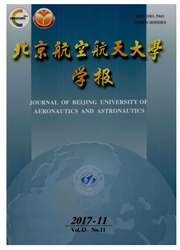

 中文摘要:
中文摘要:
飞翼布局飞机具有优越的隐身和气动特性,但由于布局原因无法配置常规控制面,因此常规布局飞机的阵风减缓控制方法不再适用。针对大展弦比飞翼布局飞机,设计了风洞模型、具有沉浮和俯仰2个方向自由度的支持系统以及能够产生连续正弦阵风的阵风发生器,采用经典控制律理论设计了能够同时减缓翼尖过载和翼根弯矩的3组控制方案,开展了阵风减缓主动控制风洞试验,对开、闭环试验数据进行了分析。试验数据表明,和正常式布局飞机不同,阵风引起的飞翼布局飞机的翼尖过载和翼根弯矩在俯仰模态对应的频率处有一个很大的峰值,而在一弯频率附近峰值比较小;对于不同控制面组合,阵风减缓效果不一样;对于飞翼布局飞机,选用合适的控制面组合可以有效减缓阵风载荷和阵风响应。
 英文摘要:
英文摘要:
Flying wing configuration aircraft is advantageous on the characteristics of stealth and aerodynamics,but due to lack of conventional elevator and rudder,gust alleviation control method for the aircraft with conventional configuration is not suitable anymore. For the flying wing configuration aircraft with large aspect ratio,a wind tunnel model,support system with two degrees of freedom of plunging and pitching,and gust generator which is capable of generating continuous sine gust are designed. Three control schemes that can simultaneously reduce wing tip acceleration and wing root bending moment are designed using classical control law theory. Wind tunnel test of gust alleviation active control is conducted and the open and closed loop test data are analyzed. Test data show that the wing tip acceleration and the wing root bending moment due to gust of flying wing aircraft have a large peak at the frequency of pitch mode,while the peak at the frequency of first bending mode is relatively small; for different combinations of control surface,the effects of gust alleviation are different; for flying wing configuration aircraft,selecting the appropriate combination of control surfaces can effectively reduce the gust load and gust response.
 同期刊论文项目
同期刊论文项目
 同项目期刊论文
同项目期刊论文
 期刊信息
期刊信息
